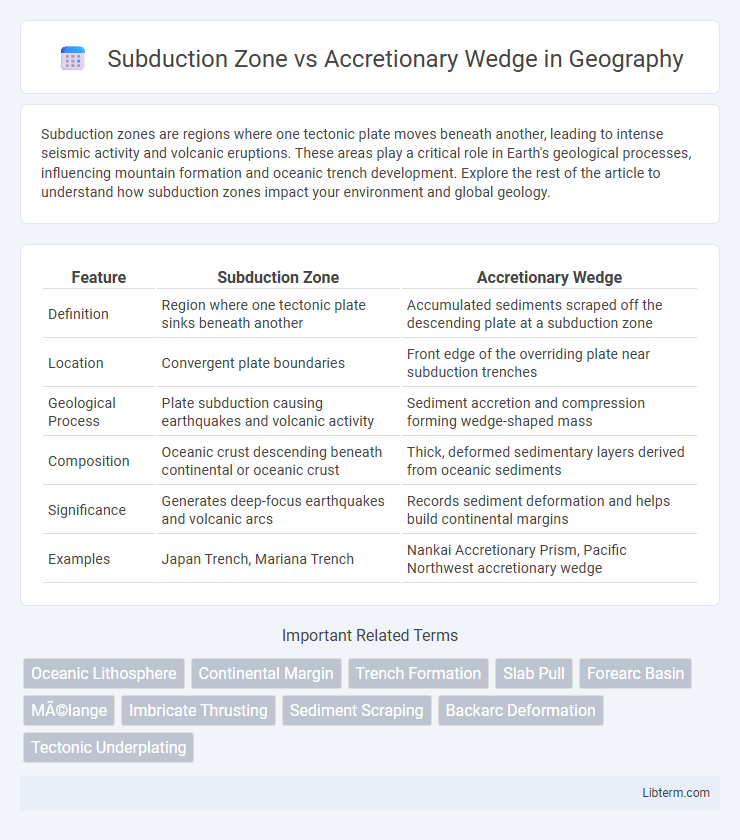Subduction zones are regions where one tectonic plate moves beneath another, leading to intense seismic activity and volcanic eruptions. These areas play a critical role in Earth's geological processes, influencing mountain formation and oceanic trench development. Explore the rest of the article to understand how subduction zones impact your environment and global geology.
Table of Comparison
| Feature | Subduction Zone | Accretionary Wedge |
|---|---|---|
| Definition | Region where one tectonic plate sinks beneath another | Accumulated sediments scraped off the descending plate at a subduction zone |
| Location | Convergent plate boundaries | Front edge of the overriding plate near subduction trenches |
| Geological Process | Plate subduction causing earthquakes and volcanic activity | Sediment accretion and compression forming wedge-shaped mass |
| Composition | Oceanic crust descending beneath continental or oceanic crust | Thick, deformed sedimentary layers derived from oceanic sediments |
| Significance | Generates deep-focus earthquakes and volcanic arcs | Records sediment deformation and helps build continental margins |
| Examples | Japan Trench, Mariana Trench | Nankai Accretionary Prism, Pacific Northwest accretionary wedge |
Introduction to Subduction Zones and Accretionary Wedges
Subduction zones are regions where one tectonic plate sinks beneath another into the mantle, generating intense geological activity such as earthquakes and volcanic eruptions. Accretionary wedges form at these convergent boundaries through the accumulation and deformation of sediments scraped off the subducting plate, creating complex geological structures. Understanding the interplay between subduction zones and accretionary wedges is crucial for comprehending plate tectonics and associated geohazards.
Defining Subduction Zones
Subduction zones are regions where one tectonic plate descends beneath another into the mantle, driving intense geological activity including earthquakes and volcanic eruptions. These zones form deep oceanic trenches and are characterized by the marked descent of oceanic lithosphere beneath continental or oceanic plates. The accretionary wedge, a mass of sediments and rocks scraped from the subducting plate, accumulates at the edge of the overriding plate, providing critical insights into the processes of deformation and material transport within subduction zones.
What is an Accretionary Wedge?
An accretionary wedge is a mass of sediment and rock scraped off the subducting oceanic plate and accumulated at the convergent boundary of a subduction zone. It forms as sediments from the ocean floor are scraped and compressed against the overriding continental plate, creating a complex geological structure consisting of folded and faulted materials. This wedge plays a critical role in earthquake generation and mountain building processes associated with subduction zones.
Geological Processes in Subduction Zones
Subduction zones are tectonic plate boundaries where one plate descends beneath another into the mantle, generating intense pressure, heat, and seismic activity. An accretionary wedge forms at these convergent boundaries as sediments and oceanic crust are scraped off the subducting plate and accumulate, creating complex geological structures like fold-thrust belts. These processes drive mountain building, volcanic activity, and earthquake generation, playing a crucial role in the Earth's lithospheric recycling and crustal deformation.
Formation and Structure of Accretionary Wedges
Accretionary wedges form at subduction zones where sediment and oceanic crust from the descending tectonic plate are scraped off and accumulated onto the overriding plate, creating a thick, wedge-shaped prism. These wedges consist of deformed sediments, melanges, and thrust faults that accommodate compressional forces, growing in size as more material is accreted through ongoing subduction. Their internal structure shows imbricated thrust sheets and folded strata, reflecting continuous sediment accumulation and deformation during plate convergence.
Key Differences Between Subduction Zones and Accretionary Wedges
Subduction zones are convergent plate boundaries where one tectonic plate slides beneath another, leading to intense seismic activity and volcanic arc formation. Accretionary wedges form at the leading edge of the overriding plate in subduction zones, consisting of scraped sediments and oceanic crust material accreted from the subducting plate. The key difference lies in their geological roles: subduction zones drive plate tectonics and mantle recycling, while accretionary wedges build up sedimentary prisms and influence forearc basin development.
Plate Tectonics and Crustal Dynamics
Subduction zones are regions where an oceanic plate converges and is forced beneath a continental or another oceanic plate, driving significant crustal recycling and intense seismic activity. Accretionary wedges form at convergent plate boundaries due to the accumulation and deformation of sediments scraped off the downgoing oceanic plate, influencing crustal thickening and orogenesis. These processes are fundamental to plate tectonics and crustal dynamics, contributing to mountain building, volcanic arcs, and the evolution of Earth's lithosphere.
Role in Earthquake and Tsunami Generation
Subduction zones are tectonic boundaries where one plate is forced beneath another, generating powerful megathrust earthquakes that can trigger devastating tsunamis. Accretionary wedges, formed from sediments scraped off the subducting plate, can lock and store elastic strain, influencing seismic slip behavior and earthquake rupture propagation. The interplay between subduction interface dynamics and accretionary wedge structure is critical in determining earthquake magnitude and tsunami potential.
Real-World Examples and Case Studies
The Cascadia Subduction Zone off the Pacific Northwest coast exemplifies a convergent boundary where the Juan de Fuca Plate subducts beneath the North American Plate, generating a prominent accretionary wedge composed of sediments scraped from the oceanic plate. In the Nankai Trough, southwest Japan, complex interactions between the Philippine Sea Plate and the Eurasian Plate have created a well-studied accretionary prism exhibiting detailed seismic activity and sediment deformation. The Makran Subduction Zone in the Arabian Sea offers another case where an active accretionary wedge forms due to the Arabian Plate's subduction beneath the Eurasian Plate, enabling extensive research on sediment accretion and tectonic processes.
Conclusion: Importance in Understanding Plate Boundaries
Subduction zones and accretionary wedges play crucial roles in understanding the dynamics of convergent plate boundaries, where one tectonic plate is forced beneath another. The study of subduction zones reveals the mechanisms driving volcanic activity, earthquakes, and oceanic trench formation, while accretionary wedges highlight sediment accumulation and deformation processes along the plate interface. Together, these features provide essential insights into seismic hazards and the geochemical cycles shaping Earth's crust and mantle interactions.
Subduction Zone Infographic

 libterm.com
libterm.com